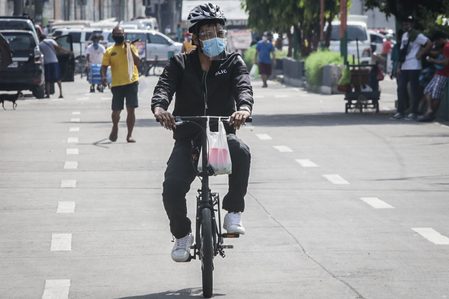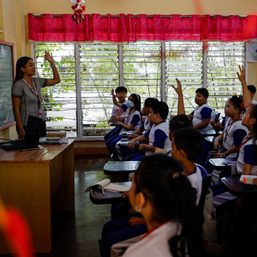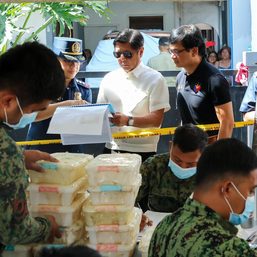SUMMARY
This is AI generated summarization, which may have errors. For context, always refer to the full article.
Philippine President Rodrigo Duterte has approved a trial run of face-to-face classes in areas deemed at “low risk” for COVID-19 to take place in 2021, Malacañang announced on Monday, December 14.
Duterte made the decision during a Cabinet meeting, said Presidential Spokesperson Harry Roque in a message to reporters.
The approved proposal, put forth by the Department of Education (DepEd), involves the “pilot implementation or dry run of face-to-face classes in select schools within areas with low COVID risk for the whole month of January 2021.”
It’s not yet clear when in 2021 these face-to-face classes will start. But they will only take place in areas categorized by the national government as low risk as of January.
Roque, however, later said the pilot test may happen in January. DepEd said it had asked “authority to conduct pilot in January.”
“The pilot shall be done under strict health and safety measures, and where there is commitment for shared responsibility among DepEd, local government units, and parents,” said Roque.
Attendance of students to face-to-face classes will only be “voluntary on the part of the learner or parents,” said the Duterte spokesman.
Parents must issue a permit for a student to be allowed to participate in the physical classes.
What’s a low-risk area?
The government defines a low-risk area using two indicators: average daily attack rate (ADAR) and two-week growth rate (2WGR).
A low-risk area has an ADAR that is less than 1. ADAR is the number of new cases in a city or province over a two-week period, divided by the population of the city or province.
It must also have a 2WGR that is less than, or equal, to 0.
Two-week growth rate is the percent increase or decrease of the number of new cases in the past two weeks, compared to the number of new cases in the two previous weeks. It’s basically a comparison of the new cases detected one week ago and two weeks ago, and those new cases detected 3 weeks ago and 4 weeks ago.
Change in decision
Duterte’s latest decision goes against his declaration last May to prohibit face-to-face classes until a vaccine is available to Filipinos. During that time, the DepEd had also been considering allowing face-to-face classes in low-risk areas as the August school opening neared.
Last November 24, senators urged the government to consider resuming face-to-face classes, as they expressed apprehensions about whether students, especially those unable to take online classes, are able to retain much from the current modes of remote learning.
But student group Samahan ng Progresibong Kabataan or SPARK warned that resuming face-to-face classes in the middle of a pandemic is dangerous given the lack of health infrastructure, as well as gaps in testing and contact tracing.
The Department of Health, however, said it supported face-to-face classes in low-risk areas, or areas where the pandemic is under control.
DepEd guidelines
In a statement on Tuesday, December 15, the Department of Education (DepEd) said that the dry run of face-to-face classes will help them and policymakers to come up with “more comprehensive recommendations and initiatives for learning continuity moving forward.”
“The Department would also like to emphasize that learners will not be compelled to participate and can continue their distance learning setup. Selected schools will require consent from parents allowing their children to join the limited face-to-face classes,” it added.
From December 14 to 18, regional field units of the DepEd will nominate schools for the pilot implementation.
On December 28, Education Secretary Leonor Briones will choose the final pilot schools.
Below is the timeline of activities of the dry run:
– with a report from Bonz Magsambol/Rappler.com
Add a comment
How does this make you feel?



![[Time Trowel] Evolution and the sneakiness of COVID](https://www.rappler.com/tachyon/2024/02/tl-evolution-covid.jpg?resize=257%2C257&crop=455px%2C0px%2C1080px%2C1080px)


![[The Slingshot] Red zipper on the mouth of Sara Duterte](https://www.rappler.com/tachyon/2024/04/TL-red-zipper-sara-duterte-april-12-2024.jpg?resize=257%2C257&crop=335px%2C0px%2C720px%2C720px)

![[OPINION] How about setting up a heat health warning system in PH schools?](https://www.rappler.com/tachyon/2024/04/heat-health-warning-system-in-PH-schools.jpg?resize=257%2C257&crop_strategy=attention)

![[ANALYSIS] The multiplier effect of negligence in education](https://www.rappler.com/tachyon/2024/04/The-multiplier-effect-of-negligence-in-education.jpg?resize=257%2C257&crop=277px%2C0px%2C720px%2C720px)
![[The Slingshot] Alden Delvo’s birthday](https://www.rappler.com/tachyon/2024/04/tl-alden-delvo-birthday.jpg?resize=257%2C257&crop=263px%2C0px%2C720px%2C720px)
![[EDITORIAL] Ang low-intensity warfare ni Marcos kung saan attack dog na ang First Lady](https://www.rappler.com/tachyon/2024/04/animated-liza-marcos-sara-duterte-feud-carousel.jpg?resize=257%2C257&crop=294px%2C0px%2C720px%2C720px)
![[Newsstand] Duterte vs Marcos: A rift impossible to bridge, a wound impossible to heal](https://www.rappler.com/tachyon/2024/04/duterte-marcos-rift-apr-20-2024.jpg?resize=257%2C257&crop=278px%2C0px%2C720px%2C720px)


There are no comments yet. Add your comment to start the conversation.